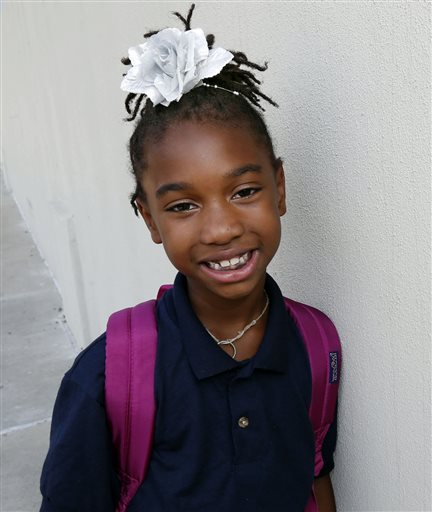
This Sept. 8, 2013 photo shows Tiana Parker, 7, who was removed from the Deborah Brown Community School due to the school’s policy against her natural hairstyle, poses for a photo outside the Tulsa, Okla. school. On Monday, Sept. 9, 2013 the school board voted to change its policy that had banned dreadlocks, afros and other hairstyles. (AP Photo/Tulsa World, Cory Young) ONLINE OUT; TV OUT; TULSA OUT
TULSA, Okla. (AP) — An Oklahoma charter school has changed its dress code after inciting criticism for telling a 7-year-old girl that her dreadlocks violated the school’s policy.
Tiana Parker and her parents said she was summoned last month to the administrator’s office at the Deborah Brown Community School in Tulsa and told her hairstyle was against school policy. Her parents later decided to move Tiana to another school.
But Monday night, the school board voted to change its policy that had banned dreadlocks, afros and other hairstyles. Dreadlocks are formed by matting or braiding hair.
The new policy says only that students and parents are responsible for personal hygiene and that administrators have the right to contact parents or guardians regarding such issues. There are no specifications on hair styles.
School board president Kenneth James said in a statement that it was not the school administration’s intent to harm Tiana or her family and he apologized if any harm did occur.
James said the ban on dreadlocks, afros and other hairstyles was due to health and safety concerns.
A spokeswoman for the Parker family did not immediately return a message from The Associated Press for comment.
Tiana’s parents, Terrance and Miranda Parker, did not attend Monday night’s school board vote. In a statement issued to the Tulsa World, the Parkers said no board decision could “change the fact that our 7-year-old daughter Tiana was made to feel that there was something wrong with her appearance, in turn coming home in tears.”
They said they have been contacted by community leaders, civil rights advocates, women empowerment groups and attorneys, and are “exploring all of their options.”
The school says nearly 100 percent of its students are African-American.



